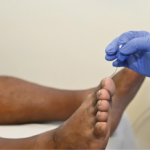 EULAR 2022 (VIRTUAL)—Rheumatologists and patients alike often benefit from the recommendations produced by national and international professional societies that help synthesize the medical literature and provide guidelines for diagnosis and management of diseases. At the 2022 Congress of the European Alliance of Associations for Rheumatology (EULAR), updates of recommendation on anti-neutrophil cytoplasmic antibody (ANCA) associated vasculitis (AAV), axial spondyloarthritis (axSpA) and rheumatoid arthritis (RA) were presented in a thorough and helpful manner.
EULAR 2022 (VIRTUAL)—Rheumatologists and patients alike often benefit from the recommendations produced by national and international professional societies that help synthesize the medical literature and provide guidelines for diagnosis and management of diseases. At the 2022 Congress of the European Alliance of Associations for Rheumatology (EULAR), updates of recommendation on anti-neutrophil cytoplasmic antibody (ANCA) associated vasculitis (AAV), axial spondyloarthritis (axSpA) and rheumatoid arthritis (RA) were presented in a thorough and helpful manner.
ANCA-Associated Vasculitis
Bernhard Hellmich, MD, chair, Department of Medicine, Rheumatology and Immunology at the Medius Klinik Kirchheim, Kirchheim Unter Teck, Baden-Württemberg, Germany, began the session with an overview of recommendations for AAV. Dr. Hellmich noted that the prior sets of EULAR guidelines for the management of AAV, which came in 2008 and 2016, were in need of updating given new research and clinical developments in the field.
Several overarching principles for the recommendations on managing AAV include: 1) Patients with AAV should be offered the best care based on shared decision making between the patient and the physician considering efficacy, safety and costs; 2) patients should have access to education focusing on the impact and prognosis of AAV, including potential treatment-related complications; and 3) patients should be periodically screened for treatment-related adverse effects and comorbidities and be guided with prophylaxis and lifestyle modification recommendations to reduce complications and comorbidities.
In addition, AAV is rare, heterogeneous and potentially life- and organ-threatening, so multidisciplinary management is essential.
A new recommendation included using testing for both proteinase 3 (PR3) ANCA and myeloperoxidase (MPO) ANCA using a high-quality, antigen-specific assay—as opposed to indirect immunofluorescence—as the primary method of testing in patients with potential signs and/or symptoms of AAV.
A revised recommendation is that rituximab is now the preferred agent for treatment of patients with organ- or life-threatening AAV with relapsing disease.
The group also revised a recommendation on induction of remission in patients with non-organ- and non-life-threatening AAV and now note that rituximab, rather than methotrexate, should be the first-line agent. This is in part because treatment with methotrexate or another agent—mycophenolate mofetil—often leads to patients requiring higher doses of concomitant glucocorticoids.
GPA & MPA
Another new recommendation uses the PEXIVAS trial to guide the quicker tapering of glucocorticoids for patients with granulomatosis with polyangiitis (GPA) or microscopic polyangiitis (MPA).1 PEXIVAS also evaluated the use of plasma exchange, and EULAR now recommends against plasma exchange for routine use in treating alveolar hemorrhage in patients with GPA/MPA. Plasma exchange can be considered for remission induction in patients with serum creatinine >300 µmol/L due to active glomerulonephritis.
Dr. Hellmich stated that new data on avacopan prompted EULAR to recommend its use in combination with rituximab or cyclophosphamide for induction of remission in GPA or MPA to reduce exposure to glucocorticoids.
In another revision, rituximab is recommended as the first-line treatment for maintenance of remission in patients with GPA or MPA, with methotrexate and azathioprine as alternatives. In addition, to maintain remission, treatment should be continued for at least 24–48 months for patients with new-onset disease, and longer duration can be considered for patients with relapsing disease or risk factors for relapse.
EGPA
Dr. Hellmich explained that eosinophilic GPA (EGPA) now has several of its own recommendations rather than being grouped with GPA and MPA. Mepolizumab has been of interest for the treatment of patients with EGPA since a landmark study in 2017 on this subject.2 It is indicated for induction of remission and for maintenance of remission in patients with relapsing or refractory EGPA without organ- or life-threatening disease.
Altogether, the revised and new recommendations for the management of AAV recognize distinctions between various forms of vasculitis and incorporate the most relevant data from important studies in recent years.
Axial Spondyloarthritis
Sofia Ramiro, MD, MSc, PhD, consultant rheumatologist and senior researcher, Leiden University Medical Center and Zuyderland Medical Center, the Netherlands, next provided an overview of the 2022 Assessment of SpondyloArthritis international Society (ASAS)/EULAR recommendations for the management of axial spondyloarthritis.
The algorithm used in the recommendations begins with ensuring the patient has a clinical diagnosis of axSpA, noted Dr. Ramiro. This may seem self-evident, but she notes that it is important not to diagnose patients based on classification criteria for disease because these are intended for research purposes and do not translate in all cases to correct clinical diagnoses in real-world practice. Another overarching principle is that in all patients with axSpA education on the disease, regular exercise, physiotherapy and smoking cessation should be at least considered as aspects of treatment.
For all patients with axSpA, EULAR recommends a trial of at least two non-steroidal anti-inflammatory drugs over a total of four weeks, and patients with predominant peripheral manifestations should be given at least one local steroid injection, if appropriate. A therapeutic trial of sulfasalazine is also recommended for these patients.
Dr. Ramiro explained that for patients who require escalation to a biologic or targeted synthetic disease-modifying anti-rheumatic drug (DMARD), agents may include tumor necrosis factor-α (TNFα) inhibitors, interleukin (IL) 17 inhibitors or Janus kinase (JAK) inhibitors. In clinical practice, however, more data exist on the use of TNFα inhibitors and IL-17 inhibitors in patients with axSpA, so these treatments are more commonly used than JAK inhibitor therapy.
A new recommendation from EULAR is if a patient has recurrent uveitis or active inflammatory bowel disease, then preference should be given to a TNFα inhibitor, and patients with psoriasis should receive IL-17A inhibitor therapy.
Dr. Ramiro provided an important statement on the recommendation that absence of response to treatment should trigger reevaluation of the diagnosis and consideration for the presence of comorbidities that may be limiting effectiveness of treatment. In cases where additional treatment with a biologic DMARD or targeted synthetic DMARD is still indicated, a TNFα inhibitor, IL-17 inhibitor or JAK inhibitor is reasonable to consider. If a patient does achieve sustained remission, then tapering of a biologic DMARD could be considered.
Rheumatoid Arthritis
Josef Smolen, MD, professor of internal medicine and chairman, Department of Rheumatology, Vienna General Hospital, University of Vienna, Austria, concluded the session by discussing recommendations on the management of rheumatoid arthritis. In 2021, the ACR published an updated guideline on the management of rheumatoid arthritis (see highlights online).3 One departure EULAR takes from the 2021 ACR guideline is the EULAR recommendation in favor of combining a first-line DMARD, such as methotrexate, with short-term glucocorticoids.
Dr. Smolen noted the ACR guideline had a very low to moderate level of evidence in the recommendation against use of short-term glucocorticoids as part of initial therapy.3 He acknowledged that glucocorticoids can increase the risk of certain adverse outcomes for patients, such as via cardiovascular risks, but he noted that it is unclear if these risks are substantially increased in the short term as well as the long term. He also explained that the NORD-STAR trial indicated that methotrexate combined with glucocorticoids was noninferior to methotrexate combined with certolizumab, as well as to methotrexate combined with tocilizumab, in achieving a 15% reduction in Clinical Disease Activity Index (CDAI) score at 24 weeks.4
On the subject of JAK inhibitor therapy, Dr. Smolen pointed out the ORAL Surveillance study showed an increased risk of major adverse cardiac events (MACE) and cancers in patients treated with tofacitinib compared with those receiving a TNFα inhibitor.5 This has been an important and complex subject because other literature at least questions if these associations hold true across all patients with RA. Also, because the ENTRACTE study did not show increased MACE risk with tocilizumab vs. etanercept, the increased MACE risk in the ORAL Surveillance study is unlikely to be due to inhibition of IL-6 signaling.6
This has led EULAR to recommend that if the treatment target is not achieved with the first conventional synthetic DMARD and poor prognostic factors are present, then a biologic DMARD should be added, and a targeted synthetic DMARD could be considered, but pertinent risk factors for MACE or malignancy must be taken into account.
Finally, Dr. Smolen noted the recommendations indicate that when sustained remission has been achieved, glucocorticoids are the first drug category that should be tapered, followed by biologic DMARDs, targeted synthetic DMARDs and conventional synthetic DMARDs.
Jason Liebowitz, MD, completed his fellowship in rheumatology at Johns Hopkins University, Baltimore, where he also earned his medical degree. He is currently in practice with Skylands Medical Group, N.J.
References
- Walsh M, Merkel PA, Peh CA, et al. Plasma exchange and glucocorticoids in severe ANCA-associated vasculitis. N Engl J Med. 2020 Feb 13;382(7):622–631.
- Wechsler ME, Akuthota P, Jayne D, et al. Mepolizumab or placebo for eosinophilic granulomatosis with polyangiitis. N Engl J Med. 2017 May 18;376(20):1921–1932.
- Fraenkel L, Bathon JM, England BR, et al. 2021 American College of Rheumatology guideline for the treatment of rheumatoid arthritis. Arthritis Care Res (Hoboken). 2021 Jul;73(7):924–939.
- Lund Hetland M, Haavardsholm EA, Rudin A, et al. A multicenter randomized study in early rheumatoid arthritis to compare active conventional therapy versus three biological treatments: 24 week efficacy and safety results of the NORD-STAR trial [abstract]. Arthritis Rheumatol. 2019;71(suppl 10).
- Ytterberg SR, Bhatt DL, Mikuls TR, et al. Cardiovascular and cancer risk with tofacitinib in rheumatoid arthritis. N Engl J Med. 2022 Jan 27;386(4):316–326.
- Giles JT, Sattar N, Gabriel S, et al. Cardiovascular safety of tocilizumab versus etanercept in rheumatoid arthritis: A randomized controlled trial. Arthritis Rheumatol. 2020 Jan;72(1):31–40.





